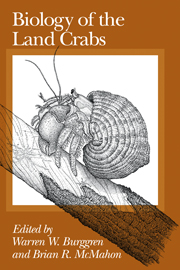Book contents
- Frontmatter
- Contents
- List of contributors
- Preface
- 1 BIOLOGY OF THE LAND CRABS: AN INTRODUCTION
- 2 EVOLUTION, SYSTEMATICS, AND GEOGRAPHICAL DISTRIBUTION
- 3 ECOLOGY
- 4 BEHAVIOR
- 5 REPRODUCTION AND DEVELOPMENT
- 6 GROWTH AND MOLTING
- 7 ION AND WATER BALANCE
- 8 RESPIRATION
- 9 CIRCULATION
- 10 ENERGETICS AND LOCOMOTION
- 11 EPILOGUE
- APPENDIX: Natural histories of selected terrestrial crabs
- References
- Author index
- Systematic index
- Subject index
4 - BEHAVIOR
Published online by Cambridge University Press: 04 August 2010
- Frontmatter
- Contents
- List of contributors
- Preface
- 1 BIOLOGY OF THE LAND CRABS: AN INTRODUCTION
- 2 EVOLUTION, SYSTEMATICS, AND GEOGRAPHICAL DISTRIBUTION
- 3 ECOLOGY
- 4 BEHAVIOR
- 5 REPRODUCTION AND DEVELOPMENT
- 6 GROWTH AND MOLTING
- 7 ION AND WATER BALANCE
- 8 RESPIRATION
- 9 CIRCULATION
- 10 ENERGETICS AND LOCOMOTION
- 11 EPILOGUE
- APPENDIX: Natural histories of selected terrestrial crabs
- References
- Author index
- Systematic index
- Subject index
Summary
Introduction
This chapter presents information on the wide variety of behavioral adaptations associated with terrestrial and semiterrestrial crab genera. Because of the fragmentary nature of much of the available literature, the following is by no means an exhaustive review. It is our intention to provide a comprehensive basis for those interested in continuing research on the fascinating array of behavioral adaptations observed in these crab genera.
Among the many “land crabs” discussed in this volume, the behaviors of the fiddler crabs (Uca spp.) and the ghost crabs (Ocypode spp.) are best known. These and their near relatives constitute the family Ocypodidae Ortmann 1884. Some reference will be made to lesserknown ocypodid genera, such as Dotilla, Scopimera (sand-bubbler crabs), Heloecius (semaphore crabs), Macrophthalmus (sentinel crabs), and Mictyris (soldier crabs; Mictyridae), where information is available. Unfortunately, most of these genera are relatively poorly studied.
The classic work on ocypodid behavior is Crane's very comprehensive volume, Fiddler Crabs of the World (1975), in which she devotes two full chapters, and sections of others, to behavior. Since her review covers the literature through 1970 (with a few more recent references), and is well documented, the reader is referred to that volume for detailed sources of the older literature. Major aspects of behavior will be summarized here, with particular attention given to more recent studies.
Fiddler crabs and ghost crabs occur in open habitats, on sandy beaches and mudflats, where they are conspicuous to humans. They also actively move about in large numbers during periods of low tide (also see Chapter 3).
- Type
- Chapter
- Information
- Biology of the Land Crabs , pp. 97 - 138Publisher: Cambridge University PressPrint publication year: 1988
- 18
- Cited by

